In the last posting to this blog page—the essay topic was “Medicine in Literature” (https://stephenageller.com/2024/10/12/medicine-in-literature/ )—I considered some of the writings—novels, plays, stories and some non-fiction— in which medicine plays a role. This time it’s films.
As briefly pointed out in the last posting, I began an elective for students at New York’s Mount Sinai School of Medicine in the late 1970s and continued it until 1984, when I moved to Los Angeles and the Cedars-Sinai Medical Center. Although UCLA students did come to Cedars-Sinai to spend parts of their clinical years (the first part of medical school is generally “pre-clinical”–anatomy, physiology, pharmacology and other courses–and the last years are “clinical,” where students learn directly from interacting with patients) they did not have direct contact with Pathology. Pathology is the bridge between pre-clinical and clinical. For that reason, I did not initially transfer the elective Medicine in Literature to Los Angeles.
Also, instead of more than 100 students from which to draw, there were only approximately 30 “house staff” members, including mostly residents (post-graduates studying a specialty, in our case, Pathology) and some fellows (post-residency physicians in a super-specialty such as liver pathology, lung pathology, transfusion medicine, etc.). In the first years of the 21st century, I surveyed the residents and fellows to determine if there was any interest in literature. Somewhat to my surprise eight to ten house staff members expressed an interest and participated each year, utilizing the same books listed in the previous post. A few faculty members also asked to join. In addition, the sessions were held in the early evening with Kate providing an (always) delicious meal, including some scrumptious home-made dessert.
After a few years, with the increasing availability of DVDs, I offered “Medicine in Film.” After all, we were in Hollywood! We showed the films in the department’s conference room, with wine/soft drinks and bread and cheese, followed by a discussion of the medical aspects of the film as well as of the film itself. The attendance was consistent with “regulars” showing up for each screening and the enthusiasm for considering the medical aspects was often greater than for the overall production.
1939 is considered by many to be the finest year in the history of moviemaking. Of the 10 motion pictures nominated for the best picture Academy Award, 6 include medicine or a doctor as significant plot points.
Gone With the Wind, the Oscar winner and still one of the greatest films ever made, has an unforgettable scene of Atlanta, after Sherman marched through, in which the streets
are filled with the injured and dying. Doctor Meade (played by Harry Davenport, who played a doctor in other movies), is a community leader and cares for many of the characters, including Ashley Wilkes (Leslie Howard), wounded after a nighttime raid to avenge an attack on Scarlett O’Hara (Vivien Leigh), as well as the dying Melanie Wilkes (Olivia de Havilland). If you have never seen this marvelous, timeless film, you have deprived yourself of an extraordinary experience.
Thomas Mitchell, Scarlett O’Hara’s father in Gone With the Wind, performed as Doc Boone in Stagecoach, the film that launched John Wayne’s career and also earned Mitchell an Oscar for best actor in a supporting role.
The death of Cathy (Merle Oberon) is a key scene in Wuthering Heights (a new version is apparently in production but it is hard for me to conceive of anyone but Olivier as Heathcliff or, for that matter, anyone but the ethereal Oberon as the gentle Cathy). Similarly, the death of Catherine Chipping (the marvelous and under-appreciated Greer Garson) in Goodbye Mr. Chips, is a major turning point for that lovely motion picture.
Glioblastoma multiforme, the highly aggressive brain tumor killing the socialite Judy Traherne (Bette Davis), is as much a part of the plot of Dark Victory as any of the notable cast members (including Humphrey Bogart and president-to-be Ronald Reagan).
Finally, in Love Affair, the wheelchair-bound Terry McKay (Irene Dunne) fails to show up for a planned rendezvous at the Empire State Building with the playboy Michel Marnet (Charles Boyer). The drama is heightened as he knows nothing of the disabling accident that she sustained on the way to meet him. This film rejuvenated the career of Leo McCarey as a director and 18 years later, McCarey made almost the same film, retitled An Affair to Remember. This 1957 version is a far better movie, with Deborah Kerr as Terry and Cary Grant as the marginally successful painter, Nickie Ferrante. Both films include the male character’s grandmother, Janou (Maria Ouspenskaya in the original and then Catherine Nesbit), who serves to require another hankie when she dies.
There is even a physician in The Wizard of Oz. After Dorothy’s house falls on the first wicked witch, he pronounces her dead.
We didn’t use any of these 1939 films for our sessions and, just as with books, we had a long list (below) from which to choose.
A few films were only used once. A few were repeated from year to year as the participants changed.
With a screenplay by Paddy Chayefsky and the starring role played by the always potentially explosive George C. Scott (Academy Award best actor winner for Patton), 1971’s 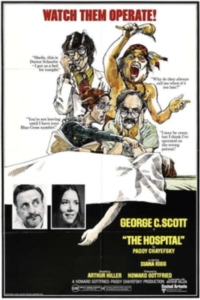 The Hospital is a wonderful motion picture, even if it has decidedly dark overtones. Dr. Herbert Bock, the Chief of Medicine at a large, big, city hospital, is a brilliant physician whose life is in disarray; his wife and his children don’t talk to him and his once-great teaching hospital is falling apart with the unexplained death of two doctors and a nurse. He is impotent until he meets Barbara Drummond (the always wonderful Diana Rigg), who brings her eccentric father (Bernard Hughes) from Mexico for treatment. The movie was filmed at New York’s Metropolitan Hospital. In 1995, The Hospital was deemed “culturally, historically or aesthetically significant” when it was selected for preservation in the United States National Film Registry. For young physicians, this movie offers insight into some aspects of medical care in the late 20th century, including how cardiac resuscitation was managed. It also considers the not-always-helpful influences by hospital administration and community leaders on the practice of medicine.
The Hospital is a wonderful motion picture, even if it has decidedly dark overtones. Dr. Herbert Bock, the Chief of Medicine at a large, big, city hospital, is a brilliant physician whose life is in disarray; his wife and his children don’t talk to him and his once-great teaching hospital is falling apart with the unexplained death of two doctors and a nurse. He is impotent until he meets Barbara Drummond (the always wonderful Diana Rigg), who brings her eccentric father (Bernard Hughes) from Mexico for treatment. The movie was filmed at New York’s Metropolitan Hospital. In 1995, The Hospital was deemed “culturally, historically or aesthetically significant” when it was selected for preservation in the United States National Film Registry. For young physicians, this movie offers insight into some aspects of medical care in the late 20th century, including how cardiac resuscitation was managed. It also considers the not-always-helpful influences by hospital administration and community leaders on the practice of medicine. 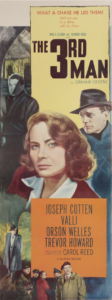 The Third Man, written by Graham Greene and directed by Carol Reed, is considered one of the finest films ever made. It is certainly one of my favorites, worth watching over and over again. Set in post-World War II allied-occupied Vienna, this 1949 noir thriller tells the story of Holly Martins (Joseph Cotton), an almost penniless writer of western novels, who comes to Vienna to accept a job offered by his old friend, Harry Lime (Orson Welles). On arrival, however, he is told that Lime was killed by a
The Third Man, written by Graham Greene and directed by Carol Reed, is considered one of the finest films ever made. It is certainly one of my favorites, worth watching over and over again. Set in post-World War II allied-occupied Vienna, this 1949 noir thriller tells the story of Holly Martins (Joseph Cotton), an almost penniless writer of western novels, who comes to Vienna to accept a job offered by his old friend, Harry Lime (Orson Welles). On arrival, however, he is told that Lime was killed by a
hit-and-run driver. He meets various friends of Lime, including his girlfriend, the actress Anna Schmidt (played by the marvelous Alida Valli) and, with Anna, finds that the various accounts of Lime’s death differ in several ways. Martins is determined to find out what really happened and enlists the help of British Major Calloway (Trevor Howard). I won’t disclose the medical aspect of this great movie except to note that the same problem exists today in impoverished countries around the world. This is a great, almost flawless, film and, if you’ve never seen it, you should find a copy and watch it (two or three times).
Julie Andrews stars in Duet for One, a thoughtful and moving motion picture about a great violinist who develops multiple sclerosis. The story is thought to be modeled on the life of the brilliant cellist Jacqueline du Pré. Du Pré “grew up” artistically with the renowned musicians Zubin Mehta, Itzhak Pearlman, Pinchas Zuckerman and Daniel Barenboim (who she married). The Trout is a marvelous documentary that records the London meeting of these five exceptional talents in order to record the Schubert Trout quintet. In it, they are all eternally young and happy and full of joy. Du Pré, regarded as one of the greatest cellists of the 20th century, died in 1987 at the age of 42. The film was released a year earlier. Alan Bates and Max von Sydow co-star. In a minor, but significant, role. Liam Neeson is also in this film. 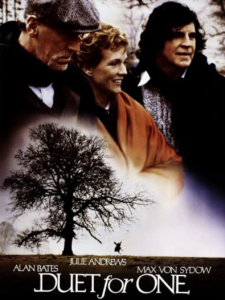 Duet for One was originally a 1980 play by Tom Kempinski, who claimed that the idea for the film was his own and not based on du Pré, although her illness became publicly known after 1973. Julie Andrews, the wonderful, cheerful Mary Poppins as well as the ebullient Maria of Sound of Music, is marvelous as Stephanie Anderson, a decidedly serious role for which she earned a Golden Globe award as best actress.
Duet for One was originally a 1980 play by Tom Kempinski, who claimed that the idea for the film was his own and not based on du Pré, although her illness became publicly known after 1973. Julie Andrews, the wonderful, cheerful Mary Poppins as well as the ebullient Maria of Sound of Music, is marvelous as Stephanie Anderson, a decidedly serious role for which she earned a Golden Globe award as best actress.
Hilary and Jackie, a 1988 film, is based on the book A Genius in the Family, written by Jacqueline du Pré’s sister, Hilary, a flautist, and brother, Piers. It stars Emily Watson as Jacqueline and Rachel Griffiths as Hilary, with James Frain as Daniel Barenboim. Multiple sclerosis is certainly a part of the story, but the film is more about the relationship of the sisters and of what is purported to be a breakdown by Jacqueline. The film was well regarded, particularly for the performances by Watson and Griffiths, but also criticized for obvious distortions of fact.
Edward G. Robinson is Paul Ehrlich in Dr. Ehrlich’s Magic Bullet, an excellent motion picture about the determination of the brilliant physician and scientist, 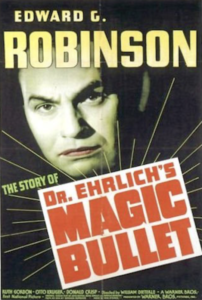 1908 Nobel Prize winner, to find a “magic bullet,” a medication that could be injected to act on a specific disease, in this instance, syphilis.
1908 Nobel Prize winner, to find a “magic bullet,” a medication that could be injected to act on a specific disease, in this instance, syphilis.
Paul Ehrlich was one of the greatest scientists of all time and this thoughtful and engrossing film highlights some aspects of his life. If you are interested in medicine and/or Ehrlich, it is a reasonably accurate and sensible retelling of one of the great scientific events of all time which, in effect, led to the creation of the field of chemotherapy. Even if you have no interest in medicine or Ehrlich, it’s a very fine film and worth seeing, particularly since the principal performance is by Robinson, one of the greatest film actors of the 20th century.
In a very minor coincidence, the film was directed by William Dieterle, originally an actor in Germany before coming to America where he
established a career as an excellent director (The Hunchback of Notre Dame, The Life of Emile Zola, The Life of Louis Pasteur, A Midsummer Night’s Dream and many others). A stain once used by pathologists for syphilis, and a few other infectious disorders, is the Dieterle stain. The two Dieterle’s are not known to be related and this association is known only by a retired pathologist with a memory bank of peculiar and obscure facts (me) and, now, you, the unsuspecting reader who will have absolutely no use for this information.
In 1970, the year M*A*S*H* was released, the futility of the Vietnam war was becoming increasingly obvious, at least on the two coasts. Protests against the war, against Richard Nixon and against the military in general, were everyday events. The Boeing 747 began service, the Nuclear Non-Proliferation Treaty went into effect, NASA’s Apollo 13 mission to the moon was aborted after 4 days because of a technical problem. In that same year, 4 students were killed and 9 wounded at Kent State University by Ohio National Guardsmen, horrifying the nation in an almost unheard of (at least for now) use of United States military against American citizens. Near the end of the year, Nixon announced the withdrawal of 40,000 troops from Vietnam.
M*A*S*H*, a highly sardonic comedy directed by Robert Altman from a script by Ring Lardner, Jr., was a huge hit with both anti-war Americans, of which there were increasing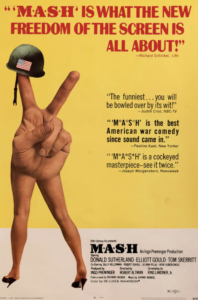 numbers, and the public at large. The film launched the careers of Donald Sutherland (“Hawkeye” Pierce), Elliot Gould (“Trapper John” McIntrye), Tom Skerritt (“Duke” Forrest) and Robert Duvall (Major Frank Burns) and many others. Hawkeye, Trapper John and Duke are brilliant surgeons but highly iconoclastic, consistently breaking rules, insubordinate and womanizing. Although it takes place at a Mobile Army Surgical Hospital (MASH) during the Korean War, it was clearly intended to be a statement against the Vietnam War. In addition to the ribald comedy that is the main structure of the film, Altman included many seemingly gory scenes of injured soldiers and operative procedures. The haunting song, “Suicide is Painless,” based around the camp dentist, “Painless” Waldowski (John Schuck) became independently popular. The film was also criticized for its blatantly anti-religious sub-theme.
numbers, and the public at large. The film launched the careers of Donald Sutherland (“Hawkeye” Pierce), Elliot Gould (“Trapper John” McIntrye), Tom Skerritt (“Duke” Forrest) and Robert Duvall (Major Frank Burns) and many others. Hawkeye, Trapper John and Duke are brilliant surgeons but highly iconoclastic, consistently breaking rules, insubordinate and womanizing. Although it takes place at a Mobile Army Surgical Hospital (MASH) during the Korean War, it was clearly intended to be a statement against the Vietnam War. In addition to the ribald comedy that is the main structure of the film, Altman included many seemingly gory scenes of injured soldiers and operative procedures. The haunting song, “Suicide is Painless,” based around the camp dentist, “Painless” Waldowski (John Schuck) became independently popular. The film was also criticized for its blatantly anti-religious sub-theme.
It is a funny movie but when I saw it again, a few weeks ago, I became more aware of the mean-spirited and cruel nature of some parts. Still, it is a brilliant film, with Altman’s direction setting a pattern for many motion pictures to come. Two years later, the milder television version of M*A*S*H* began a highly successful 11-year run starring Alan Alda and Wayne Rogers, although Altman said it was “the antithesis of everything we were trying to do” with the movie.
Another, not particularly interesting, film, Battle Circus, also used a MASH unit in Korea as its setting. Made approximately 20 years before M*A*S*H*, it starred Humphrey Bogart and June Allyson. I did not utilize this bland, formulaic film in the elective.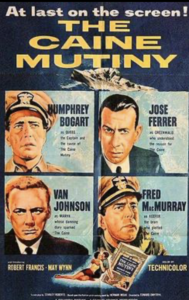 Three great American novels about World War II came soon after the war ended: Norman Mailer’s The Naked and the Dead, Irwin Shaw’s The Young Lions and Herman Wouk’s The Caine Mutiny. Later, there would be many other fine WW II novels, such as Vonnegut’s Slaughterhouse Five and Heller’s Catch-22. Wouk’s book won the Pulitzer and is an excellent read. The Caine Mutiny movie script changes the novel in a number of ways but still emerges as a first-rate story, with bravura performances by Humphrey Bogart, as Philip Queeg, the flawed captain of the U.S.S. Caine, a minesweeper in the South Pacific, Van Johnson as the ethical and heroic executive office, Steve Maryk, Fred MacMurray as the duplicitous would-be novelist, Tom Keefer, and José Ferrer as the brilliant, principled defense attorney, Barney Greenwald. The pivotal courtroom scene is gripping and many thought Bogart should have gotten the Academy Award for his performance in the film. Using The Caine Mutiny in our elective allowed us to consider psychologic disorders instead of the usual physical ailments. Unlike M*A*S*H*, this motion picture stands the test of time well.
Three great American novels about World War II came soon after the war ended: Norman Mailer’s The Naked and the Dead, Irwin Shaw’s The Young Lions and Herman Wouk’s The Caine Mutiny. Later, there would be many other fine WW II novels, such as Vonnegut’s Slaughterhouse Five and Heller’s Catch-22. Wouk’s book won the Pulitzer and is an excellent read. The Caine Mutiny movie script changes the novel in a number of ways but still emerges as a first-rate story, with bravura performances by Humphrey Bogart, as Philip Queeg, the flawed captain of the U.S.S. Caine, a minesweeper in the South Pacific, Van Johnson as the ethical and heroic executive office, Steve Maryk, Fred MacMurray as the duplicitous would-be novelist, Tom Keefer, and José Ferrer as the brilliant, principled defense attorney, Barney Greenwald. The pivotal courtroom scene is gripping and many thought Bogart should have gotten the Academy Award for his performance in the film. Using The Caine Mutiny in our elective allowed us to consider psychologic disorders instead of the usual physical ailments. Unlike M*A*S*H*, this motion picture stands the test of time well.
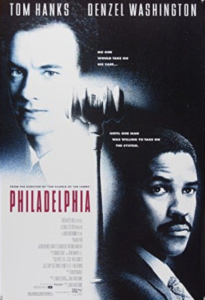 Young hospital-based physicians of today rarely care for patients with AIDS since there are now excellent medications to treat, and even prevent, this devastating, usually fatal condition. Philadelphia is a painfully beautiful, Academy Award-winning film, that depicts the effects of the disease on a young, successful, middle-class attorney, both in terms of the physical and physiologic manifestations as well as the ways in which society treated AIDS patients in the early days of the epidemic. The film explores the homophobia that was extant, with both male and female characters affected. Tom Hanks performance as Andrew Beckett is brilliant (as he is in so many films) as is that of Denzel Washington, who plays Joe Miller, the only lawyer willing to take the case when Beckett is wrongfully fired from his prestigious law firm. Philadelphia earned 11 Academy Awards, including one for Bruce Springsteen’s haunting song “Street of Philadelphia.” Equally haunting from the movie are Neil Young’s “Philadelphia” song and the aria “La mamma morta” from Puccini’s opera Andrea Chenier, sung by Maria Callas.
Young hospital-based physicians of today rarely care for patients with AIDS since there are now excellent medications to treat, and even prevent, this devastating, usually fatal condition. Philadelphia is a painfully beautiful, Academy Award-winning film, that depicts the effects of the disease on a young, successful, middle-class attorney, both in terms of the physical and physiologic manifestations as well as the ways in which society treated AIDS patients in the early days of the epidemic. The film explores the homophobia that was extant, with both male and female characters affected. Tom Hanks performance as Andrew Beckett is brilliant (as he is in so many films) as is that of Denzel Washington, who plays Joe Miller, the only lawyer willing to take the case when Beckett is wrongfully fired from his prestigious law firm. Philadelphia earned 11 Academy Awards, including one for Bruce Springsteen’s haunting song “Street of Philadelphia.” Equally haunting from the movie are Neil Young’s “Philadelphia” song and the aria “La mamma morta” from Puccini’s opera Andrea Chenier, sung by Maria Callas.
The Quiet Duel is one of the many outstanding films by director Akira Kurosawa, starring his favorite actor Toshiro Mifune. The Quiet Duel has excellent subtitles and takes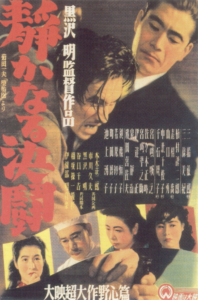 place during the last years of WW II. Dr. Kyogi Fujisaki (Mifune), a young, idealistic Japanese Army physician cuts himself while operating on a patient who has syphilis and contracts the disease. In those years, before the availability of penicillin, syphilis was a severe, unrelenting and often fatal disease. Returning home, after the war, to work in his father’s clinic, he finds the man from whom he was infected with syphilis as a patient who now has signs of advanced syphilis. Fujisaki does not reveal that he has the shameful disease. He refuses to marry the woman he loves and who loves him and treats himself with salvarsan, the not-always-effective arsenical drug developed at the end of the 19th century by Paul Ehrlich. Seeing this film, as well as Dr. Ehrlich’s Magic Bullet (above) helps young physicians, who rarely see syphilis, understand how terrible this infection once was and also shows how it can be transmitted in non-sexual ways. Salvarsan and syphilis are also plot elements in the breathtakingly beautiful film, Out of Africa, which stars Meryl Streep and Robert Redford. At one point, Karen Blixen (Streep) contracts syphilis from her philandering husband (Klaus Maria Brandauer) and temporarily leaves Kenya to return to her native Denmark for salvarsan therapy. Until penicillin replaced it, salvarsan was the most widely prescribed drug in the world.
place during the last years of WW II. Dr. Kyogi Fujisaki (Mifune), a young, idealistic Japanese Army physician cuts himself while operating on a patient who has syphilis and contracts the disease. In those years, before the availability of penicillin, syphilis was a severe, unrelenting and often fatal disease. Returning home, after the war, to work in his father’s clinic, he finds the man from whom he was infected with syphilis as a patient who now has signs of advanced syphilis. Fujisaki does not reveal that he has the shameful disease. He refuses to marry the woman he loves and who loves him and treats himself with salvarsan, the not-always-effective arsenical drug developed at the end of the 19th century by Paul Ehrlich. Seeing this film, as well as Dr. Ehrlich’s Magic Bullet (above) helps young physicians, who rarely see syphilis, understand how terrible this infection once was and also shows how it can be transmitted in non-sexual ways. Salvarsan and syphilis are also plot elements in the breathtakingly beautiful film, Out of Africa, which stars Meryl Streep and Robert Redford. At one point, Karen Blixen (Streep) contracts syphilis from her philandering husband (Klaus Maria Brandauer) and temporarily leaves Kenya to return to her native Denmark for salvarsan therapy. Until penicillin replaced it, salvarsan was the most widely prescribed drug in the world.
Bruce Pearson (Robert de Niro, little known at the time of this 1973 movie) is a major league baseball player, a catcher, of limited ability and even more limited intellect, whose best friend is Henry Wiggen (Michael Moriarty), a star pitcher who is brainy and highly educated. Wiggen is in contract dispute with management. Bang the Drum Slowly is about their friendship. Together they secretly go to the Mayo Clinic when Pearson is ailing and they learn 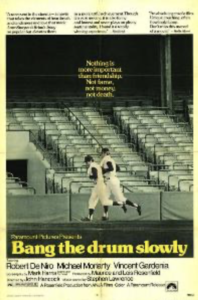 that he has Hodgkin lymphoma, then an almost universally fatal disease. When Pearson’s performance on the field begins to lag, Wiggen suddenly agrees to sign for another season if he and Pearson, who is about to be sent down to the minor leagues, are considered as a single package. Despite the grim theme, the film offers considerable entertainment and is often quite funny. The script is outstanding and the highly affecting performances first-rate, although only relatively little attention is paid to Pearson’s medical issues. Al Pacino once referred to Bang the Drum Slowly as his favorite film.
that he has Hodgkin lymphoma, then an almost universally fatal disease. When Pearson’s performance on the field begins to lag, Wiggen suddenly agrees to sign for another season if he and Pearson, who is about to be sent down to the minor leagues, are considered as a single package. Despite the grim theme, the film offers considerable entertainment and is often quite funny. The script is outstanding and the highly affecting performances first-rate, although only relatively little attention is paid to Pearson’s medical issues. Al Pacino once referred to Bang the Drum Slowly as his favorite film.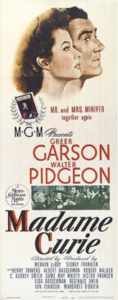 Madame Curie is one of the better biopics made. Greer Garson stars as the Nobel Prize-winning Polish French physicist, who discovers radium and Walter Pidgeon plays her French husband and scientific collaborator, Pierre. The film grips one’s attention because of the way it portrays the struggles and excitement of scientific discovery and also because of the inherent chemistry, talent and charm of the two lead actors. This 1943 production is a terrific motion picture for all ages, including children, and does not demand knowledge of science or medicine. It also highlights how women were often considered second-class and unworthy. The film was directed by the amazingly talented Mervyn LeRoy (who is rarely mentioned as part of the pantheon of great film directors but should be). Among LeRoy’s casting discoveries are: Clark Gable, Lana Turner, Loretta Young, Jane Wyman, Robert Mitchum, Sophia Loren and Audrey Hepburn.
Madame Curie is one of the better biopics made. Greer Garson stars as the Nobel Prize-winning Polish French physicist, who discovers radium and Walter Pidgeon plays her French husband and scientific collaborator, Pierre. The film grips one’s attention because of the way it portrays the struggles and excitement of scientific discovery and also because of the inherent chemistry, talent and charm of the two lead actors. This 1943 production is a terrific motion picture for all ages, including children, and does not demand knowledge of science or medicine. It also highlights how women were often considered second-class and unworthy. The film was directed by the amazingly talented Mervyn LeRoy (who is rarely mentioned as part of the pantheon of great film directors but should be). Among LeRoy’s casting discoveries are: Clark Gable, Lana Turner, Loretta Young, Jane Wyman, Robert Mitchum, Sophia Loren and Audrey Hepburn.
Other films considered and/or utilized for the elective:
film
actor(s)/theme(s)
A Child is Waiting
Judy Garland, Burt Lancaster child psychiatry
Amour
Jean-Louis Trintingant, Emanuelle Riva Alzheimer
And the Band Played On
Matthew Mondine, Alan Alda AIDS
Andromeda Strain, The
James Olson, Arthur Hill epidemic
Arrowsmith
Ronald Colman, Helen Hayes idealistic physician
Awakenings
Robin Williams, Robert de Niro encephalitis lethargica
Away From Her
Julie Christie Alzheimer
Bang the Drum Slowly
Michael Moriarty, Robert de Niro baseball player develops Hodgkin lymphoma
Battle Circus
Humphrey Bogart, June Allyson mobile surgery unit, Korea
Born on the Fourth of July
Tom Cruise paraplegia
Bringing out the Dead
Nicholas Cage, Patricia Arquette paramedics, addiction
Caine Mutiny, The
Humphrey Bogart, Van Johnson psychosis at sea, WW II
Camille
Greta Garbo, Robert Taylor tuberculosis
Citadel, The
Robert Donat, Rosalind Russell idealistic physician, coal miner lung
Coma
Genevieve Bujold, Michael Douglas harvesting organs
Contagion
Lawrence Fishbourne, Kate Winslet contagion
Critical Care
James Spader, Helen Mirren vegetative state (comedy)
Dark Victory
Bette Davis, George Brent high grade malignant brain tumor
Dead Ringers
Jeremy Irons, Genevieve Bujold twin gynecologists
Death in Venice
Dirk Bogarde cholera, obsession
Diving Bell and the Butterfly, The
Mathieu Amalric, Emmanuele Seigne locked-in syndrome
Doctor at Large, Doctor in the House, etc.
Dirk Bogarde comedies about young doctors
Doctor Zhivago
Omar Sharif, Julie Christie epic story of doctor/poet, Russian revolution
Doctor, The
William Hurt, Christine Lahti arrogant surgeon develops cancer
Double Helix, The
Jeff Goldblum, Juliet Stevenson discovery of DNA
Dr. Ehrlich’s Magic Bullet
Edward G. Robinson Paul Ehrlich biopic, discovery of syphilis therapy
Duet for One
Juliet Andrews, Alan Bates violinist develops multiple sclerosis
Dying Young
Julia Roberts, Campbell Scott leukemia, heroin
Elephant Man, The
Anthony Hopkins, John Hurt neurofibromatosis
English Patient, The
Ralph Fiennes, Juliette Binoches severe burns, WW II
Extraordinary Measures
Brendan Fraser, Harrison Ford Pompe disease, biotechnology
Extreme Measures
Hugh Grant, Gene Hackman illegal spinal experiments
First Do No Harm
Meryl Streep epilepsy
Flatliners
Kiefer Sutherland, Julia Roberts medical students, near-death experiences
Freud: The Secret Passion
Montgomery Clift, Susannah York Sigmund Freud biopic
Girl in White, The
June Allyson, Arthur Kennedy pioneering woman surgeon
Gifted Hands
Cuba Gooding, Jr. Ben Carson biopic
Great Moment, The
Joel McCrea discovery of ether anesthesia
Gross Anatomy
Matthew Modine, Christine Lahti medical school tragicomedy
Hilary and Jackie
Emily Watson, Rachel Griffiths famous cellist develops multiple sclerosis
History of Louis Pasteur, The
Paul Muni Louis Pasteur biopic
Horseman on the Roof
Olivier Martinez, Juliette Binoche plague
Hospital, The
George C. Scott, Diana Rigg inner city hospital tragicomedy
Internes Can’t Take Money
Joel McCrea, Barbara Stanwyck first Dr. Kildare film
Iris
Judi Dench, Jim Broadbent Alzheimer
Island, The
Scarlett Johannsen, Sean Bean human cloning
John Q
Denzel Washington, Robert Duvall emergency department taken hostage
King’s Row
Robert Cummings, Ronald Reagan trauma/amputation, depression
Last Angry Man, The
Paul Muni, David Wayne growth of specialties affect Brooklyn M.D.
Last King of Scotland, The
Forest Whitaker, James McAvoy Idi Amin’s doctor
Lorenzo’s Oil
Susan Sarandon, Nick Nolte orphan drugs
Love Story
Ali McGraw, Ryan O’Neill leukemia
M*A*S*H*
Donald Sutherland, Elliot Gould mobile surgery unit Korea
Madame Curie
Greer Garson, Walter Pidgeon Marie Curie biopic
Madness of King George, The
Nigel Hawthorne, Helen Mirren porphyria and George III
Magnificent Obsession
Rock Hudson, Jane Wyman neurosurgery
Malice
Alec Baldwin, Nicole Kidman oophorectomy, malpractice
Marvin’s Room
Diane Keaton, Meryl Streep marrow transplant, psychiatry
Mask
Cher, Eric Stolz, Sam Elliot facial deformity (“lionitis”)
Medicine Man
Sean Connery, Lorraine Bracco finding cancer cure in jungle
Memento
Guy Pearce anterograde amnesia
Men, The
Marlon Brando paraplegia ward in a Veterans’ hospital
Miss Evers’ Boys
Alfre Woodard Tuskegee syphilis experiments
My Left Foot
Daniel Day-Lewis cerebral palsy
My Own Country
Naveen Andrews, Glenne Headley AIDS in Tennessee
My Sister’s Keeper
Cameron Diaz, Alec Baldwin marrow transplantation
No Way Out
Sidney Poitier, Richard Widmark hospital care and bigotry
Not as a Stranger
Frank Sinatra, Robert Mitchum obsessed, manipulative young doctor
Now Voyager
Bette Davis, George Brent neurotic disorder
Of Human Bondage
Bette Davis, Leslie Howard young physician enthralled
One Flew Over the Cuckoo’s Nest
Jack Nicholson, Louise Fletcher psychiatric ward, frontal lobotomy
One True Thing
Meryl Street, Renee Zellweger daughter comes home to care for sick mother
Painted Veil, The
Edward Norton, Naomi Watts cholera
Panic in the Streets
Paul Douglas, Richard Widmark plague in New Orleans
Passion Fish
Mary McDonnell, Alfre Woodard trauma-induced paralysis
Patch Adams
Robin Williams doctor who treats with humor biopic
People Will Talk
Cary Grant, Jeanne Crain pregnancy, depression, suicide
Persona
Bibi Anderson, Liv Uhlmann pregnancy, hysteria
Philadelphia
Tom Hanks, Denzel Washington AIDS
Physician, The
Tom Payne, Ben Kingsley 10th C boy travels Europe to become physician
Prince of Tides, The
Barbara Streisand, Nick Nolte psychiatry
Quiet Duel, The
Toshiro Mifune doctor contacts syphilis from patient’s blood
Red Beard
Toshiro Mifune old doctor and young doctor have conflicts
Sea Inside, The
Javier Bardem quadriplegia, euthanasia
Seconds
Rock Hudson plastic surgery transforms middle-aged man
Shadowlands
Anthony Hopkins, Debra Winger C.S. Lewis and cancer
Sleeper
Woody Allen man awakes 200 years after surgery
Small Change
Francois Truffaut child abuse
Snake Pit, The
Olivia de Havilland insane asylum
Still Alice
Julianne Moore Alzheimer
Something the Lord Made
Mos Def, Alan Rickman gifted janitor assists pioneering heart surgeon
Spellbound
Ingrid Bergman, Gregory Peck possible murderer heads psychiatric hospital
State of Emergency
Joe Montegna neurotoxin horror movie
Terms of Endearment
Debra Winger, Shirley McLain lymphoma
Theory of Everything, The
Eddie Redmayne, Felicity Jones Stephen Hawking biopic, ALS
Third Man, The
Joseph Cotton, Valli, Orson Welles post-WW II Vienna black market
Three Faces of Eve, The
Joanne Woodward schizophrenia
W’it
Emma Thompson terminal cancer, euthanasia
Whose Life is it Anyway?
Richard Dreyfus, Christine Lahti paralysis, euthanasia
Yellow Jack
Robert Montgomery yellow fever in Cuba, 1898
Young Doctors, The
Frederic March, Ben Gazzara old doctor and young doctor have conflicts

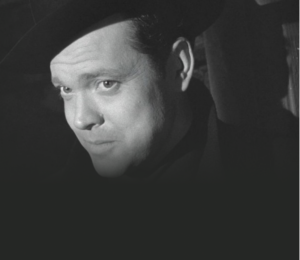
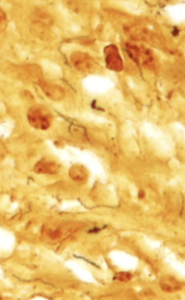
October 31, 2024 at 6:18 pm
This is a truly extraordinary gift, Steve. Your knowledge of the films , their disease- medical significance and sharing are amazing and generous.
Now, please help me find out how to obtain access to any of them….all I know are you- tube and Netflix
Also, may I share this with my sister, dear cousins, children….????
Thank you very much
Milton
November 3, 2024 at 10:09 am
I read A. J. Cronin’s “The Citadel” with you and your group at Mount Sinai. Once we finished reading this very fine book, I felt very embarrassed that I had never heard of it before you suggested that we read it.
As I recall, we saw the movie during our last session. The ending was so different from the book that it was a huge disappointment to me.
November 3, 2024 at 11:34 am
You are absolutely correct. The book is far better than the movie.